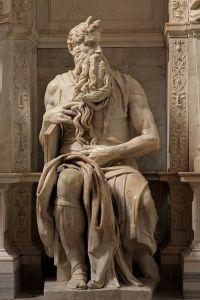I was reading the account of the Transfiguration the other day, the way that you do, when a thought occurred to me. How did Pete, Jim, and John know that Moses was there? Yes, Elijah came along too, but the Bible physically describes Elijah. They at least knew what he wore. But Moses lived some thousand years before and the Good Book says nothing about what he looked like or his clothes. Fashions didn’t change so quickly back then. When they did it was often because an invading army from another nation was living in your town. If you wanted to blend in you’d start dressing like a Persian. Or an Assyrian. Otherwise people tended to have a set of clothes that might help identify them at a distance. But holy Moses…
One of the commandments he handed down declared images to be prohibited. There were no pictures made of Moses, no portraits. Our view of Moses comes from sources like Michelangelo and the Charlton Heston character based on Michelangelo’s vision. The inner circle of disciples could presumably make some educated guesses—Moses would be bearded, but so would most men. Beyond that, how do you recognize someone who’s been dead for over a millennium and for whom no images or recordings were ever made? Peter was so confused he suggested camping out on the mountain in housing with private booths. Was it something Moses said that gave him away?

Photo credit: Jörg Bittner Unna, Wikimedia Commons
Or did he have a shiny face and/or horns? The Hebrew Bible’s a bit unclear on the point. Horns, far from being a symbol of the Devil in those days, were a sign of divinity. All the gods were wearing them. Call it divine fashion. Uncomfortable with the implications, later readers decided the Hebrew word meant something like “shining” or “glowing.” That fits in well with the Transfiguration theme, but horns had been signs of power and authority for millennia. Rewriting history, however, has become the fashion of this day. Picture the scene: four men on a mountain top, a bright cloud comes down and engulfs them. Now there are six, a holy half-dozen. Moses, tradition said, had been translated to Heaven. Same was true of Elijah. But also Enoch. Of the three only Enoch has no recorded words in canonical scripture. Then suddenly the mountaintop experience is over and the apostles have to face another Monday. At least they’d had a glimpse of Moses and apparently had no doubt of who he was.
